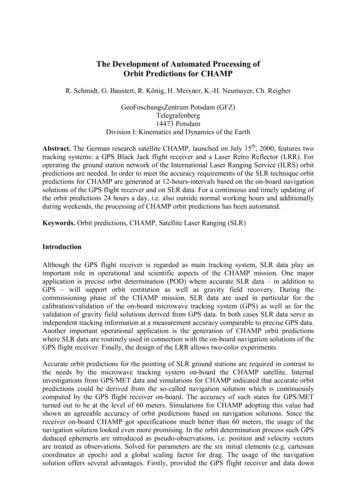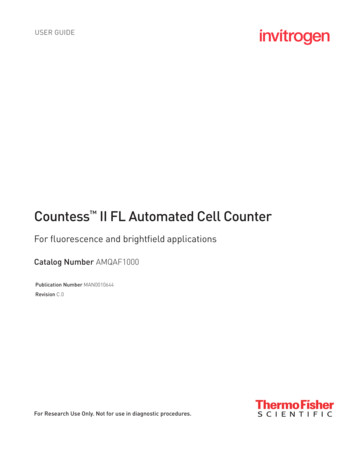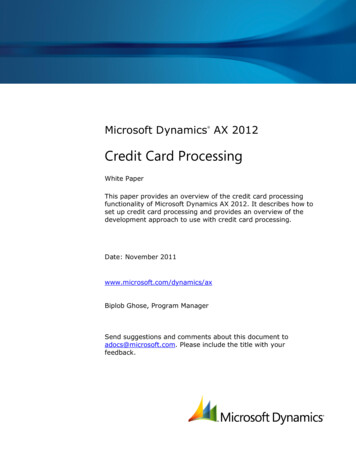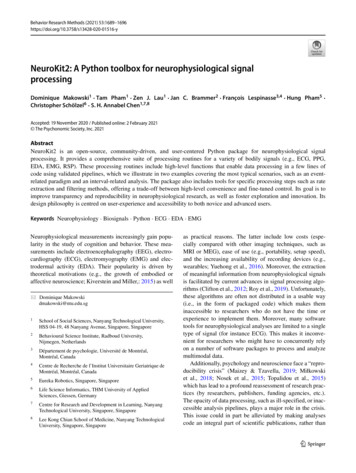
Transcription
The Development of Automated Processing ofOrbit Predictions for CHAMPR. Schmidt, G. Baustert, R. König, H. Meixner, K.-H. Neumayer, Ch. ReigberGeoFoschungsZentrum Potsdam (GFZ)Telegrafenberg14473 PotsdamDivision I: Kinematics and Dynamics of the EarthAbstract. The German research satellite CHAMP, launched on July 15th, 2000, features twotracking systems: a GPS Black Jack flight receiver and a Laser Retro Reflector (LRR). Foroperating the ground station network of the International Laser Ranging Service (ILRS) orbitpredictions are needed. In order to meet the accuracy requirements of the SLR technique orbitpredictions for CHAMP are generated at 12-hours-intervals based on the on-board navigationsolutions of the GPS flight receiver and on SLR data. For a continuous and timely updating ofthe orbit predictions 24 hours a day, i.e. also outside normal working hours and additionallyduring weekends, the processing of CHAMP orbit predictions has been automated.Keywords. Orbit predictions, CHAMP, Satellite Laser Ranging (SLR)IntroductionAlthough the GPS flight receiver is regarded as main tracking system, SLR data play animportant role in operational and scientific aspects of the CHAMP mission. One majorapplication is precise orbit determination (POD) where accurate SLR data – in addition toGPS – will support orbit restitution as well as gravity field recovery. During thecommissioning phase of the CHAMP mission, SLR data are used in particular for thecalibration/validation of the on-board microwave tracking system (GPS) as well as for thevalidation of gravity field solutions derived from GPS data. In both cases SLR data serve asindependent tracking information at a measurement accuracy comparable to precise GPS data.Another important operational application is the generation of CHAMP orbit predictionswhere SLR data are routinely used in connection with the on-board navigation solutions of theGPS flight receiver. Finally, the design of the LRR allows two-color experiments.Accurate orbit predictions for the pointing of SLR ground stations are required in contrast tothe needs by the microwave tracking system on-board the CHAMP satellite. Internalinvestigations from GPS/MET data and simulations for CHAMP indicated that accurate orbitpredictions could be derived from the so-called navigation solution which is continuouslycomputed by the GPS flight receiver on-board. The accuracy of such states for GPS/METturned out to be at the level of 60 meters. Simulations for CHAMP adopting this value hadshown an agreeable accuracy of orbit predictions based on navigation solutions. Since thereceiver on-board CHAMP got specifications much better than 60 meters, the usage of thenavigation solution looked even more promising. In the orbit determination process such GPSdeduced ephemeris are introduced as pseudo-observations, i.e. position and velocity vectorsare treated as observations. Solved for parameters are the six initial elements (e.g. cartesiancoordinates at epoch) and a global scaling factor for drag. The usage of the navigationsolution offers several advantages. Firstly, provided the GPS flight receiver and data down
2SCHMIDT ET AL.: AUTOMATED PROCESSING OF ORBIT PREDICTIONS FOR CHAMPlinks perform well, a continuous coverage of the CHAMP orbit at an agreeable accuracy issecured. Thus the prediction cycle becomes more stable than with the data outages asexperienced during the GFZ-1 mission where SLR was the one and only tracking system.Secondly, the incorporation of navigation solutions is rather straight forward with only littlepreprocessing required. Precise SLR data is regarded as complementary data, improving theorbit predictions with respect to accuracy. Therefore orbit predictions for CHAMP are basedon the navigation solutions of the GPS flight receiver and SLR data as available. It is evidentthat due to CHAMP’s low altitude drag becomes the dominating - however difficult to predict– disturbing force. Therefore the Inter Range Vectors (IRVs) and coefficients of the so-calleddrag functions (DRAG) for CHAMP require sub-daily updating. Because CHAMP datadumps also occur outside normal daily working hours and on weekends and holidays, theprocessing had to be automated. This paper summarizes the development of the processing oforbit predictions from the initial orbit phase when the manual processing was based onseparation information and radar tracking, up to the current operational automated processingbased on SLR- and spaceborne GPS-data. Upcoming improvements are addressed at the endof the paper.Initial Orbit PhaseDuring the initial orbit phase, i.e. approximately the first 24 hours after separation and beforethe on-board GPS receiver was switch on, no precise GPS or SLR was available. Hence, orbitdetermination and generation of orbit predictions were based on less accurate radar trackinginformation of two different kinds. One observation type was the so-called angle-tracking oftelemetry stations of the NASA polar station network and the two DLR facilities in Germany.Angle tracking data are azimuth and elevation angles of the telemetry antennae measuredduring the passes at the individual stations. Such data were treated similar to opticalobservations from star cameras within the GFZ orbit determination software EPOS. Anothersource of radar tracking consisted of two-line elements (TLE) for CHAMP computed at theGerman military-owned radar station FGAN located near Bonn/Germany. Such CHAMPTLE were derived from each individual pass at the FGAN station. At GFZ the TLE weretransformed into short arcs of a period of 8 minutes starting at the epoch of the TLE. This hasbeen done to preserve the pass-wise observational character of the individual TLE sets. The 8minutes time span represents the average duration of a single CHAMP pass over the FGANstation. Finally, the ephemeris of these TLE orbits were introduced as pseudo-observationsinto the orbit determination. Table 1 summarizes the orbital fit of the angle-tracking data, ofthe TLE ephemeris as well as of the ephemeris from the first GPS navigation solution (GPSNAV) for arcs on July 15 and on July 16. Arc 20000715 was based on the angle-tracking dataand on the TLE based ‘passes’ from FGAN. Arc 20000716 was based on angle-tracking dataand on the first navigation solution of the GPS flight receiver. The orbital fit of angle-trackingdata decreases by a factor of 3 towards approximately 60 “ which reflects the order of themeasurement accuracy of azimuth and elevation observations obtained by telemetry antennae.The initial values for the CHAMP state vector for arc 20000715 were derived from the postprocessed orbital parameters of the COSMOS launch vehicle and the actual separationinformation at separation time. On the one hand the rather bad orbital fit of angle-trackingdata in arc 20000715 is due to a degraded observation accuracy of azimuth and elevationangles when telemetry antennae were running in less accurate search mode. On the otherhand the launch of CHAMP coincided with an extraordinary geomagnetic storm making orbit
SCHMIDT ET AL.: AUTOMATED PROCESSING OF ORBIT PREDICTIONS FOR Right Ascension730 m177 “185 “9364364320000716GPS-NAVDeclinationRight Ascension30 m57 “64 “79974844843Table 1. Orbital fit of tracking data during the initial orbit phase. Azimuth and elevation angles have beenconverted to declination and right ascension. FGAN means ephemeris derived from FGAN-TLE.GPS-NAV are ephemeris from the navigation solution of the GPS flight receiver.determination and orbit prediction difficult in that period (see Figure 2). Taking the RMSvalues of table 1 as indicator for the orbit accuracy one can state that the accuracy of orbitrecovery for orbit predictions increased from several hundreds of meters to tens of meterswith the usage of the on-board GPS navigation solution. Based on the predicted orbit derivedfrom arc 20000716 the SLR station 1884 at Riga observed the first SLR pass on July 17, 2000at 00:11 UTC.Automated Generation of CHAMP Orbit PredictionsThe automated generation of CHAMP orbit predictions is based on the routinely acquisitionof the navigation solutions of the GPS flight receiver. These data sets comprise quasicontinuous ephemeris for CHAMP given in the WGS reference frame and in the GPS timescale at 10 seconds intervals. The temporal and spatial coverage of the CHAMP orbit by thenavigation solution sizes at about 98 %. The accuracy of these data turns out to be in the orderof 30 to 40 meters with the first software version implemented in the GPS flight receiver.Together with SLR observations these state vectors are introduced as pseudo-observation datainto the orbit determination process. The estimated parameters for CHAMP are the initialstate vector at epoch and one global scaling factor for drag. Figure 3 shows the flow chart ofthe automated generation of CHAMP orbit predictions. The automated process is startedshortly after the arrival of new navigation solution data via the DLR telemetry station inNeustrelitz/Germany, provided through the Information System and Data Center (ISDC) atGFZ Potsdam. The SLR data are collected on a hourly basis at the ILRS data centers CDDISJuly 15th, 2000Figure 1. Geographical distribution of tracking stationsduring the initial orbit phase.Figure 2. Geomagnetic ap indices 1995 - 2000
4SCHMIDT ET AL.: AUTOMATED PROCESSING OF ORBIT PREDICTIONS FOR CHAMPSLR data, emailauxiliary dataSLR data, hourlydumpGPS-NAVISDCEDC orbit determinationIRVs, DRAGorbit predictiongeneration of productsdisseminationCDDISGFZIRVs, DRAG, SAO, TLEFigure 3. Flow chart of the automated generation of CHAMP orbit predictionsand EDC. In addition, some stations transfer their NPs directly to GFZ via email. Thisprocedure has been initiated for immediate transfer of NPs being regarded vital during theinitial orbit phase. Additional auxiliary data sets like solar flux, geomagnetic activity, polarmotion, etc. are also frequently acquired from various sources. The first step of the processingis the collection of all relevant data sets, i.e. observations (navigation solution, SLR),auxiliary data (solar flux, geomagnetic indices, polar motion) and an initial state vector atepoch. The next step is the estimation of an improved set of orbit parameters, i.e. an improvedinitial state vector and a global scaling factor for drag. The force modeling comprises thegravitational force of the Earth, ocean-tides, Earth tides, gravitational accelerations due to themasses of Moon and Sun, non-conservative forces like drag, solar radiation and Earth albedo.For the evaluation of the surface forces a detailed 3-dimensional macro-model of the CHAMPsatellite is used. Based on the estimated parameters and the models used in the second step theCHAMP orbit is extrapolated into the future. The length of these orbit predictions is 3 days.Then, the predicted orbit is transferred into standard ILRS orbit prediction products, i.e. IRVsand coefficients of the so-called drag functions. Additionally, TLEs and SAO-elements aregenerated. Finally, all generated products are disseminated to the ILRS data centers, to theISDC and to an additional ftp-server at GFZ for back-up purposes. IRVs and DRAG are byrequest sent directly to SLR station via email, also.Data Availability and LatencyDue to the location of the DLR telemetry station at Neustrelitz/Germany at a latitude of 53degrees the number of contacts per day for CHAMP data dumps varies from 3 to 5. As can beseen from Figure 4 for the first 100 days of the mission there are two dump windows per dayof two to three consecutive contacts (i.e. consecutive revolutions) separated by gaps of about12 hours. Because of the precession of the orbital plane the contact epochs are slowly shiftingthrough the day. The gray shaded area indicates normal working hours of an operator despiteof weekends. In order to provide timely updates of the SLR orbit predictions close to theactual CHAMP data dumps, the processing had to be automated, also in view of weekendsand holidays. At the time being, the processing of a new orbit prediction is initiated after the
SCHMIDT ET AL.: AUTOMATED PROCESSING OF ORBIT PREDICTIONS FOR CHAMPFigure 4. Contacts at Neustrelitz5Figure 5. Latency of the navigation solutionlast dump of the consecutive passes of the corresponding dump window. Thus the nominalupdate rate of CHAMP orbit predictions is approximately 12 hours. Since the quality of orbitpredictions depends on the ‘freshness’ of actual observations, the delay of observational datafor both, navigation solution as well as for SLR data has been investigated. The latency of thenavigation solution, i.e. the difference between dump time and the epoch of the last statevector (i.e. the last observation) included in the corresponding data dump has been evaluatedfor 132 dump files from mid of October 2000 until the end of December 2000. The results aredisplayed in Figure 5. The horizontal axis labels the offsets in hours between dump time andthe epoch of the last state. The actual offset values have been classified at 1-hour intervals,ranging from offsets less equal 1 hour to offsets greater than 12 hours. All offsets larger than12 hours are merged in label ‘13’. The vertical axis shows the percentage of thecorresponding class. As can be seen almost 60 percent of the dumps indicate an agreeablesmall latency of less than 1 hour. Approximately 87 percent of the dumps show offsetssmaller than 8 hours. Larger offsets than 9 hours occur at about 13 percent of the investigateddata files. Such large latencies depend on the filling of the mass memory unit on-board theCHAMP satellite and at the possibilities of downloading the data. In general, the availabilityof the navigation solution is sufficient. Figure 7 depicts the situation for SLR data. A bulk ofthe data arrives 2 hours after observation. It must be emphasized that the availability of SLRdata has significantly improved by the establishment of hourly update within the ILRS inview of the CHAMP launch. Figure 8 depicts the number of passes per station for the periodJuly to October 2000. Table 2 lists some global statistics for the same period.Figure 6. Network of SLR stations tracking CHAMPFigure 7. Latency of SLR data
6SCHMIDT ET AL.: AUTOMATED PROCESSING OF ORBIT PREDICTIONS FOR CHAMPSLR Tracking Jul – Oct 2000 Figure 8. SLR passes per station. Jul – Oct 2000678 passes at 27 ILRS stations16977 NPs 25 NPs/pass 6 passes/dayTable 2. Statistics of SLR tracking Jul-Oct 2000The overall situation can be regarded as good in knowledge of the problems encountered withlow altitude targets. A more detailed look however shows the inhomogenuous distribution ofthe observed passes in the space and the time domain. Thus CHAMP SLR tracking reflectsthe capabilities of the ILRS network for tracking LEO targets. In November and December2000 the tracking record decreased to an average of about 3 passes per day, which cantypically be attributed to the weather conditions in winter on the Northern hemisphere.Accuracy of CHAMP Orbit PredictionsDue to its low orbit (initial altitude appr. 450 km) CHAMP’s large relative velocity withrespect to a SLR ground stations makes targeting difficult. Therefore accurate orbitpredictions are needed. The requirement for such a LEO spacecraft can be specified as anaccuracy of 10 milliseconds in along-track direction. Because of the low altitude again, themotion of CHAMP in that direction is strongly dominated by drag. State-of-the-art modelsused for predicting acceleration due to drag – in particular at such altitudes – will increasinglydeviate from the truth over longer periods. Hence, timely updating of orbit predictions isessential. Pre-flight simulations have shown that an update frequency at least at 12-hoursintervals is needed to keep the required accuracy. For validating this procedure, the accuracyof actual orbit predictions for CHAMP is investigated for a set of seven orbit predictions inthe period July 30 to August 6, 2000. The predicted orbits were compared to precise CHAMPorbits.Figure 9. Development of time bias of CHAMP orbitpredictions during first 24 hoursTime Bias [ms]12 [h]24 [h]36 75.0160.252.636.524.8110.570.3268.7333.1152.7Table 3. Time bias after 12, 24, and 36 hours foreach orbit prediction.
SCHMIDT ET AL.: AUTOMATED PROCESSING OF ORBIT PREDICTIONS FOR CHAMPFigure 10. Differences in radial direction ofprediction set no. 17Figure 11. Differences in cross-track directionof prediction set no. 1The reference orbits are based on GPS pseudo-ranges and carrier-phases, a refined modelingand parametrization and final values for the auxiliary data. The differences in radial, crosstrack, and along-track direction for the first 48 hours of each individual orbit prediction arecomputed. Figure 9 depicts the absolute values of the development of the time bias during thefirst 24 hours. The horizontal line at 10 milliseconds indicates the required accuracy. Thedashed vertical line marks the 12 hours update interval. Table 3 lists the time biases of eachorbit prediction after 12, 24, and 36 hours, respectively. The 1/rev oscillations visible inFigure 9 have been removed by fitting the individual time bias data to quadratic or cubicfunctions in a least squares adjustment combined with a check of significance of the estimatedpolynomial parameters. It can be seen that five of the seven investigated predictions agreewell with the 10 millisecond requirement, whereas prediction sets no. 5 and no. 6 violate it bya factor of 6 or 8, respectively. Figures 10 and 11 depict typical values for the differences ofthe orbit predictions in radial and cross-track direction for orbit prediction set no. 1 as anexample. The corresponding graphs for the other investigated prediction sets show similiarbehaviour and similar order of magnitudes. Typically, the differences are dominated byrevolution dependent oscillations with an increasing amplitude of the oscillations. In the radialdirection a linear trend is visible which however stays small with respect to the magnitude ofthe amplitude. For the differences in the cross-track direction no linear trends show up. Thedifferences in radial and cross-track direction of the investigated prediction sets are of theorder of a few meters before and at the 12 hours interval. From this it can be concluded thatthe chosen update procedure is in general sufficient to meet the accuracy requirement. It isalso clear that the along-track direction is the most critical component due to drag.Upcoming improvementsAs stated in the previous section the quality of the CHAMP orbit prediction can be consideredto be sufficient, but improvements are still favorable. The following procedurale changes willenhance the quality of CHAMP orbit predictions. First, the accuracy of the navigationsolution will increase to 10 m and better due to a planned software upgrade of the on-boardGPS receiver in January 2001. Second, the establishment of an additional dump station onSpitzbergen/Norway will increase the number of data dumps per day to almost the orbitalfrequency. Hence, it may be expected to further reduce the latency and improve theavailability of the navigation solution. The update rate of CHAMP orbit predictions can be
8SCHMIDT ET AL.: AUTOMATED PROCESSING OF ORBIT PREDICTIONS FOR CHAMPincreased accordingly. Finally, an advanced modeling with respect to a refined gravity fieldderived from CHAMP observations should help advance the accuracy of orbit predictions,too.ConclusionsDuring the initial orbit phase the CHAMP orbit determination and generation of orbitpredictions have been operated manually. Two kinds of radar tracking data (angle-tracking,two-line elements) have been successfully adopted in CHAMP orbit determination. Theaccuracy of orbit determination and prediction is limited by the poor precision of this type oftracking data. Additionally, due to an extra-ordinary geomagnetic storm at launch orbitrecovery was degraded in that period. The first SLR tracking succeeded after the switch-on ofthe GPS flight-receiver.For standard operations for the generation of CHAMP orbit predictions an automated processbased on the navigation solution of the GPS flight receiver on-board CHAMP and onadditional SLR data has been developed. SLR and space-borne GPS data are complementaryinput data with respect to accuracy and coverage. The investigation of a set of actual orbitpredictions verifies the requirement of sub-daily updating of CHAMP orbit predictions. Thechosen update rate at 12-hours intervals is in general sufficient to provide accurate orbitpredictions. Upcoming improvements with respect to accuracy and availability of thenavigation solution and a refined modeling are expected to further increase the quality ofCHAMP orbit predictions.
of weekends. In order to provide timely updates of the SLR orbit predictions close to the actual CHAMP data dumps, the processing had to be automated, also in view of weekends and holidays. At the time being, the processing of a new orbit prediction is initiated after the orbit determination orbit prediction generation of products










